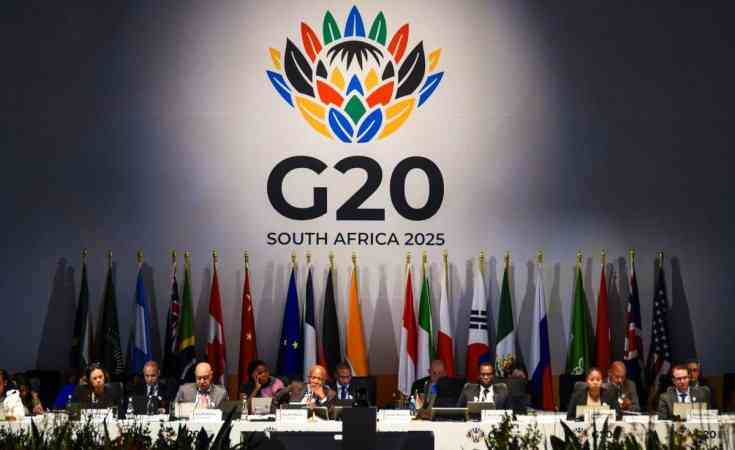
CERTAINLY, the question sounds rather frivolous now, but roll back the clock to prior to the first bombs dropping in those early morning hours of February 24 2022, and you suddenly realise it is not that much unthinkable to imagine having been exposed to Ukraine. To what extent that exposure could have been, of course would have depended on one’s offshore investment process.
Breadbasket of Europe
The Ukrainian Stock Exchange more than doubled from its lows of 220 in 2016 to about 575 in 2019. It dropped to about 500 in the following year and remained flat for about another year before embarking on a rising trend again in 2021, rising to about 530 – and then the Russian onslaught happened.
Ukraine is a US$200 billion economy.To put it into context, that is about seven times larger than our own at US$28 billion. On average, Ukraine has contributed about 0,2% of global Gross Domestic Product(GDP) and was consistently ranked number 112 of the major global economies.
For comparative purposes, South Africa, with US$400 billion in GDP, is ranked number 75. Nigeria, the African economic powerhouse, is on number 50, with about US$600 billion in GDP.
Prior to the war, Ukraine was considered an emerging, lower-middle income, mixed economy, and in a post global financial crisis era, its main economic indicators were not massively out of line.
GDP growth rate had been mostly positive for most of the years, unemployment rate was averaging less than 10%, and government debt-to-GDP ratio remained mostly below 50%. Inflation had though been a challenge, averaging north of 10% over the period.
The Ukrainian Hryvnia, its currency, averaged about ₴8,33 for every one US dollar. It even peaked to about ₴4,50 to the US dollar at the height of the global financial crisis in 2008.
- Zim headed for a political dead heat in 2023
- Record breaker Mpofu revisits difficult upbringing
- Tendo Electronics eyes Africa after TelOne deal
- Record breaker Mpofu revisits difficult upbringing
Keep Reading
Of course, it has sincenose-dived to ₴37 to the dollar following the Russian onslaught. Looking at it more closely reveals that the current depreciation in fact started in 2014, thanks to Russia again with its annexation of the Crimean Peninsula and the subsequent invasion of the Donetsk and Donbasregionsin the same year.
Modern day Ukraine is an outcome of the 1991 dissolution of the Soviet Union, has a population of about 43 million people, and is the second-largest European country after Russia.
Due to its extensive fertile land, pre-war Ukraine was one of the largest grain exporters in the world. It was among the world's top agricultural producers and exporters and was often described as the "breadbasket of Europe". It accounted for about 50% of world sunflower oil exports in 2021.
Ukraine also has a vibrant mining sector. In 2021, it was the seventh largest world producer of iron ore, the world's 8th largest producer of manganese, sixth largest producer of titanium, and seventh largest producer of graphite.
The largest nuclear power plant in Europe is in Ukraine and the country was the world's ninth largest producer of uranium in 2018. It supplies about 50% of the world's neon gas,which is an important ingredient in the production of semiconductors – a massive economic edge in an electric vehicle era. It is estimated that over 90% of US semiconductor-grade neon supplies are imported from Ukraine.
While agriculture is by far the most dominant sector, Ukraine was an active participant on the technology front too. Ukraine has previously ranked fourth in the world in number of certified IT professionals after the United States, India, and Russia. It also has ranked eighth among the world's nations in terms of internet speed.
But this piece is not about “posthumously” rooting for the Ukrainian capital market as a viable investment destination. On the contrary, it is about why a well thought-through offshore investment process would have successfully avoided Ukraine in the first place.
A country at war
To start off with, a country could be endowed with all the resources mother-earth could ever give, but there is more to what makes a jurisdiction an attractive investment destination than just its natural resources.
In the case of Ukraine, though surrounded by many developing countries, it is the poorest country in Europe by nominal GDP per capita. Corruption is a significant issue.
As of 2021 ,the country was rated 122nd out of 180 in the Corruption Perceptions Index, the second-lowest result in Europe after Russia.
This is also a country that, during the recession between 1991 and 1999, suffered from hyperinflation that peaked at 10,000% in 1993 – we all know too well here what kind of damage such frightening inflation figures can do to an economy.
There are also risks associated with the market’s smallness, low liquidity, and weak legal, political, business, and social frameworks to support a robust capital market.
All these increase the potential for bouts of extreme price volatility, illiquidity, trade barriers, and imposition of reactionary and stringent exchange controls.
Politically, Ukraine has not experienced absolute peace in centuries.
It has always been a target of invasions and occupations. Dating back to the year 1236 when the Mongolian Empire invaded and conquered Kievan Rus', modern day Ukraine, all the way to 2014 when Russia invaded and subsequently annexed Crimea, Ukraine has been a country in and out of wars.
The 2014 Russian invasion is what marked the actual beginning of the Russo-Ukrainian war we are witnessing today. February 24 2022 was just the beginning of a full-blown onslaught of a war that had already been long underway.
From 1236 to today, different European countries have taken turns to invade Ukraine. From the Khanates of Turkic origins in 1450, to Poland in 1652, to the German Empire together with the Austro-Hungarian Empire in 1918, then to France, Greece and Romania in 1919, back to Hungary again in 1939, to Nazi German in 1941, and then Russia in 2014, the country has not known peace for generations.
With all looked at together, Ukraine certainly would not have made it to the list of target investment marketsfollowing a robust and meticulous screening process of offshore investment destinations.
Even with its Stock Exchange doubling in the years 2016 to 2019, it is our firm view that even such stellar performance should not have hoodwinked anyone into having some interests in Ukrainian counters.
But in case we are wrong in arriving at such a conclusion, as some would argue that a painstaking,bottom-up approach could have pointed them to a hidden capital market gem that went on to deliver returns of more than 100% with a stable currency and inflation.
To balance things out and settle the argument, we then need to bring in the process trustees need to follow when looking into investing offshore, and that is at the centre of this thought piece.
Robust portfolio construction
Investing offshore, as with any type of investment, starts with a deep understanding of how the current portfolio’s risk-return gaps are hindering effective delivery of a fund’s risk-return objectives in line with its liabilities and benefit obligations.
Once there is clarity on that, the next step is then to look up the investment universe to identify investments that have the qualities and the risk-return characteristics that speak to the needs at hand.
Gone are the days when investing offshore was just purely a currency hedge strategy to minimise the loss-of-value impact of a depreciating domestic currency.
As we enter a mostly US dollar economic regime, US dollar-denominated returns can now be generated locally. The reasons for going offshore thus must be a lot broader now than just currency hedging – and that requires a rigorous investment decision-making process.
Important to mention that the decision to invest a portion of the fund’s assets offshore should not be driven by a desire to chase performance, but rather, by the need to achieve portfolio diversification.
By investing offshore, pension funds have an opportunity to diversify away from a small and concentrated local market and gain exposure to a broader global universe of investible companies.
Trustees should not see offshore investing as a separate component of their assets, but rather within the context of their overall investment portfolio, where it is exposed, and what its underlying assets are.
It should be about where and how to optimally access different sources of returns.
Understanding the investment universe entails understanding the different asset classes available, where they are domiciled, their sources of returns, their risk-return characteristics, and very importantly, how they perform relative to each other.
The foundation of a good investment portfolio is ensuring that the individual assets provide attractive risk-return relationships, but also endowed with adequate diversification that combines assets with low or negative correlation between them.
The offshore investment universe is a complex, convoluted, intertwined, and yet diversified space. We at times tend to think of offshore as one investment block that will always give us positive results for as long as we take out of the country the required investment capital.
That, of course, is not the case. There are so many nuances to pay attention to if pension funds are to get the equation right. With a structured approach, it is possible to break down the seemingly “herculean” task of offshore investing into a simple repeatable process with incremental fine-tuning iterations over time.
For instance, using listed stocks as an example, a good starting point would be to define the fund’s benchmark for the global equities’ component of the portfolio.
A benchmark is defined for one of two reasons, either for matching, or for beating purposes. Either way, every fund needs to clearly define its own.
While there are many market indices that can be used for listed equities benchmarks, we find the MSCI All-Country World Index to be suitable for most of our pension funds’ needs.
Many across the globe also consider the MSCI range of indices as gold standards for the different geographical regions, asset classes, sectors, and sub-sectors.
It is of course no surprise that such a benchmark does not include Ukraine of all the 50 countries from which it draws its constituents.
So even if your own analysis had given you Ukraine as a potential capital market of interest, respect for the superiority of the MSCI processes should have been good enough to see you walk away from it.
While we have developed our own 21-Ps model for assessing investment portfolios, the Process “P” is by far the one we get overly preoccupied with at the due diligence stage.
We believe it is better to get wrong results with a clear repeatable process than to stumble on a lucky outcome with a poorly conceived or executed process.
Creating and sustaining a risk-adjusted rewarding portfolio of offshore investments involves a little more than finding just one type of opportunity and buying heavily into it. Diversification remains the only “free lunch” in investments.
The Insurance and Pensions Commission (Ipec) Investment Guideline provides for a diversified approach across different asset classes. While not prescriptive on the geographical regions, to avoid an all-in-Ukraine type bet, it provides enough emphasis on the need for diversification and effective risk management, and it does so for a good reason.
Conclusion
Back to the question, what if you had betted, all-in, on Ukraine?What would be the reasonable steps to take right now? Well, to start off with, trading on Ukraine Stock Exchange has been suspended – a bad situation for most investors seeking liquidity in the short-term, but certainly one they will cherish in the long term as it helps avert what would have been otherwise a panic-induced sell-off at subdued prices.
History suggests most geopolitical events, including the Middle Eastern conflicts that threatened oil production, do not leave a lasting impression on markets.
Ukraine case could potentially be slightly different, but the point remains, patience is a virtue in investment management, and greed and fear are the enemies of great performance.
While hindsight makes us all seemingly the wiser, following a well-structured process, as the one laid out here, would have seen you avoiding Ukraine in the first place, avoiding the troubles of what to do with a significant exposure in a war-tone country that has not known lasting peace for centuries.
As we pen off, we take a moment to reflect on the human tragedy and suffering that continues to unfold in Ukraine. The human toll of political conflicts is never lost on us as we meticulouslyscrutinise and analyse global economic, investment, and capital markets for the benefit of our industry and all its members.
Mukadira is a consulting actuary at Rimca — [email protected]); Gandidzanwa is an investment consultant at Rimca — Gandy@ rim_casolutions.com










